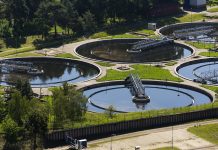By Martin Doherty
Head of Service Improvement
South West Water
Most companies in the British water industry have started the journey of creating a ‘smart’ system of management and control over their pipe network. The underground system of pipes and fittings is arguably any water company’s biggest, most complex asset. Certainly the fact that it is a buried and therefore largely unseen asset and that it is spread over a whole geographic region means that it requires a special approach in terms of monitoring condition and performance. Set against the backdrop of rapid developments in computer processing power, data analytics, cloud based high volume data storage and sensor capability, it is now more realistic to aim to put in place comprehensive real time and predictive monitoring of performance and condition for networks in a similar way to what already exists for above ground assets. South West Water is now part way through a programme aimed at achieving smart water network management across its business.
So what are the key reasons for acquiring increased insight into how your network is performing? In order to deliver and maintain high standards of customer service any water utility must be to be able to make rapid operational decisions in order to move from a position of reactive operation (where effectively your network is controlling you) to one of proactive operation (where you are in control of it). Water utilities must be aware of events or emerging situations on the network before a customer tells you about it. This puts you on the front foot for dealing with network events, enabling you to gain time to plan actions and then, if necessary, inform your customers proactively about what’s happening to their service. Ultimately, smart networks are about becoming more effective and efficient in what we do to deliver great service to our customers.
South West Water Activity
At South West Water we’re partly along a path that aims to achieve a level of intelligence that could truly be deemed to be ‘smart’. We’re now simultaneously working on advancements that we’ll make in the current AMP period through to 2020 and also including investment plans in PR19 that will decide what we do in the next AMP period covering 2020 – 2025. All of these changes align with our vision of achieving a genuinely ‘smart’ network by 2025.The South West Water network (including Bournemouth Water) comprises:
• 18,500km of water mains
• 275 service reservoirs
• 210 pump stations
• 2,700 pressure management valves
The above assets are supplied from 36 water treatment works.
The current workstreams centre around two main activities:
• Network sensors and data acquisition points – significantly increasing the number of these installations so we have the data needed for a smarter network.
• Dynamic hydraulic models – moving from ‘static’ models to ones receiving live data feeds and performing continuous, updated simulations throughout the day.
Firstly, regarding data acquisition points, we’re working on a number of different activities that are increasing our insight into network performance:
Supply Interruption Dataloggers – installation of 1,800 pressure loggers at pre-determined points across all 880 district metered areas (DMA’s). These are specifically designed to monitor network pressures and send in data at set times through the day but will shift into rapid transmission mode if a preset upper/lower threshold occurs. The sensitivity around the set thresholds is obviously key; avoiding too many (unwanted) alerts but, at the same time, not missing out on valid, wanted alerts. These alarm values are derived for every logger by analysis of a body of data received from each logger after installation. The receiving software issues a notification to a set of users as defined by business requirements. The data is also absorbed by other software systems such as the dynamic hydraulic models which use this data in their simulations.
Pressure Management Valve Conditioning Dataloggers – South West Water has some 2,700 Pressure Management Valves (PMV’s) across its water mains network. The maintenance of such a large number of PMV’s is expensive and, using traditional methods of targeting, maintenance is inefficient and poorly focussed as historically it’s based solely on timeframe schedules. This practice has three key shortcomings:
• Often the PMV is fully operational and does not require servicing so the time spent impacts operational efficiency and costs.
• Any operation on the network carries risk – bursts are often caused by inappropriate or accidental operation of valves leading to pressure surges.
• Time-based maintenance over a large asset base does not necessarily avoid PRV failures. Failures may still occur before the next planned visit.
In collaboration with i2O and using their specially developed software products we ascertained that the condition of PMVs could be inferred by analysing upstream, downstream and valve control space pressure data. We worked with them to test the hypothesis that operating costs could be significantly reduced and risks minimised by servicing PMV assets on the basis of data inferred condition based on behaviour rather than time.
We’re installing these loggers on our PMV’s; this provides us with additional data points and leverages the data through advanced algorithms to determine the condition of the PMV. This solution automatically generates reports and alerts on monitored PMVs highlighting their condition/status. The algorithms identify when a PMV is operating abnormally as well as those that are operating as expected, allowing us to follow a data driven PMV servicing programme. This philosophy delivers considerable OPEX savings, reduces network interventions and allows redirection of resource to other activity.
Pressure Management Valve Advanced Controllers – building on from the above initiative on PMV conditioning dataloggers, we’re installing advanced PMV controllers on hundreds of our PMV’s. South West Water has a challenging topography; our average zonal night pressure (AZNP) is over 52m (one of the highest in the industry) so managing pressure is key to improving service delivery and helping asset life. We’re focusing on optimising performance of those PMV’s where the increase in data acquisition and control delivers the most significant gain in terms of leakage reduction and reduction in repair job numbers (through network calming).
The controllers are able to use fixed outlet, flow modulation, time variance and critical point control; the method chosen is selected as that most appropriate to the individual characteristics of a DMA. The granularity available in the setup table in the software offers the ability to vary pressures delivered according to seasonal, diurnal, hourly (or even more frequent) requirements. These settings can be adjusted in the software remotely or via a mobile device without visiting site.
Dynamic Hydraulic Models of the Water Network – the importance of having good hydraulic models of our mains network is now well understood and the benefit to the business on both strategic and day-to-day operational issues is already considerable.
South West Water has recently become the first company globally to adopt Innovyze’s InfoWorks WS Pro & IW Live Pro hydraulic modelling software. This product builds on the long-standing Innovyze WS products for water network model builds.
WS Pro and IW Live now incorporates functionality to connect to live data from telemetry and GPRS data loggers and continually run real-time model simulations throughout the day. This provides us with a contemporary picture of network performance based on continual live data rather than on data from a calibration date many months or years before.
The improved benefits of this functionality are many-fold across operational modelling, forecasting future events, mitigating against the risk of supply interruptions and for identifying changes in the network, both scheduled and unscheduled. Being connected to live data, it can also act as an optimisation tool, suggesting changes in which the way the network is operated for teams to implement. We anticipate using our models to further optimise energy usage and to improve understanding of water quality parameters within the network.
We are also looking at an Innovyze product that further enhances network knowledge across the wider business. This product will deliver real time live modelling to field teams, control room and customer facing staff using browser technology by linking into the IW Live Pro database, illustrating model simulations as they happen. With an internet connection models can be viewed in any browser on multiple devices, including tablets and smart phones. Future developments of this will also provide the ability for operational staff to carry out their own basic model simulations when planning operational changes on the network.
Summary
The onset of the digital revolution is bringing the possibility of comprehensive smart water networks ever closer. It is essential that as an industry we innovate and grasp this opportunity with both hands; this will lead to greater efficiency, improved network performance and enhanced customer service in an ever demanding business environment.





